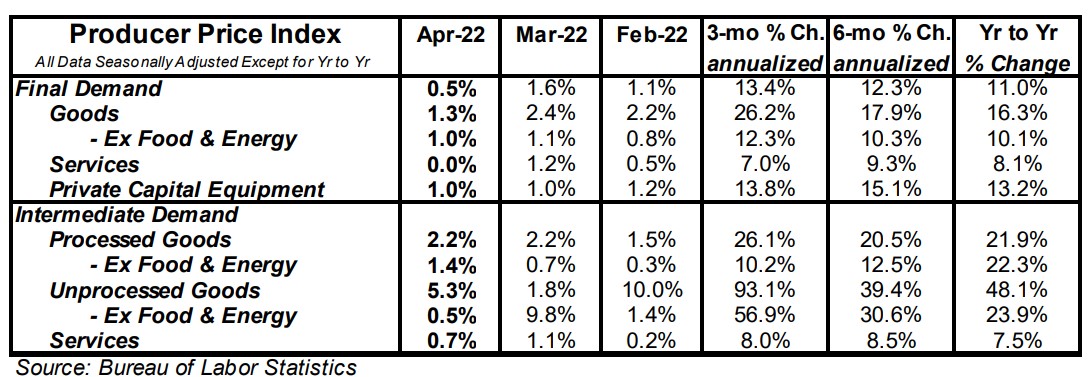- The Producer Price Index (PPI) rose 0.5% in April, matching consensus expectations. Producer prices are up 11.0% versus a year ago.
- Energy prices rose 1.7% in April, while food prices increased 1.5%. Producer prices excluding food and energy rose 0.4% in April and are up 8.8% in the past year.
- In the past year, prices for goods are up 16.3%, while prices for services have risen 8.1%. Private capital equipment prices increased 1.0% in April and are up 13.2% in the past year.
- Prices for intermediate processed goods rose 2.2% in April and are up 21.9% versus a year ago. Prices for intermediate unprocessed goods increased 5.3% in April and are up 48.1% versus a year ago.
Implications:
Inflation pressures appear to be peaking, but that doesn't mean a return to 2% inflation is anywhere on the horizon. Producer prices rose 0.5% in April following three consecutive monthly increases of 1.0% or more to start 2022. Producer prices are now up 11.0% versus a year ago, which is a modest improvement from the March reading of 11.2%, but nothing that should persuade the Fed that anything other than combating inflation is – and rightfully should be – their primary mission for the foreseeable future. Looking at the details of the April report, goods prices led the overall index higher. Energy prices rose 1.7% in April, while food prices rose 1.5% on the month, but the main drivers of inflation came from outside of these typically volatile categories. Prices for motor vehicles and equipment rose 0.8%, leading "core" producer prices higher by 0.4% in April, bringing the twelve-month increase in core prices to 8.8%. And price pressures remain elevated further back in the supply chain, as prices for processed and unprocessed goods for intermediate demand are up 21.9% and 48.1%, respectively, in the past year. On the services side of the economy, a 3.6% rise in the costs for transportation and warehousing services was offset by a decline in margins to services producers (trade services – which measures the margins received by wholesalers and retailers – fell 0.5% in April), leaving services prices unchanged for the month. In short, inflation continues to run at the highest pace in decades. This is what happens when you add money to the system at a faster pace than you can grow output. Fed Chair Jerome Powell was right in saying that the Fed needs to act "expeditiously" to address the damaging impacts of inflation, but a focus on raising interest rates and reducing the size of the Fed balance sheet are not enough by themselves. Until the Fed gets money growth under control, high inflation is here to stay. We can only hope that those in Washington learn the lesson that their actions have very real (and lasting) consequences. In other news this morning, initial unemployment claims rose 1,000 last week to 203,000. Continuing claims fell 44,000 to 1.343 million. These figures are consistent with continued growth in May.





